QuestionHow are you Mr. Robbins...I have a 20 gal tank, its been set up now for about 3 weeks. The ph is at about 7.4. I do about a 30% water change every week. I have 4 dwarf gouramis, 5 mollies, 2 red tailed black sharks, 2 small clown loaches and a catfish. I have about 5 plants in the tank, gravel, 2 pieces of wood (with a cave), and 2 good size rocks. What is a good amount of fish to put in this 20 gal tank?...i was thinking about getting 2 more clown loaches (a little bigger than the 2 i have now) and a couple of tiger barbs. And also, the water in the tank has been clowdy for the past week. Ive been using ACUREL F, it hasnt really made the water clear....do you know of any better medication for the clowdy water?..
Id appreciate any advise you could give.
Thanks a lot
Anthony
AnswerHi Anthony;
Actually, your tank is overstocked, especially for a new tank! Until a tank is fully broken in there should only be one inch of fish for every 10 gallons of water. It takes 6 to 8 weeks for a new tank to get established. In the meantime, toxins are building from fish waste and that causes the cloudiness. More about that at the end of this letter.
Once the tank breaks in, you will still have too many fish because of the potential size of the ones you have now. The safe population limit for community tanks with smaller fish is one inch per gallon. BUT....some of your fish are not smaller types, and you have to calculate based on the adult size of the fish. They are still young and some are just babies. You will need a much larger tank soon or just be prepared to find new homes for them. Here is a run-down of the potential adult size of each of your fish, as well as a link to see more info about them;
*Dwarf Gouramis - 3 inches each
http://www.fishprofiles.com/files/profiles/dwarf.xml
*Mollies - 4 to 9 inches each (depending on sex and variety)
http://www.fishprofiles.com/files/profiles/mollies.xml
http://www.fishprofiles.com/files/profiles/latsailfin.xml
http://www.fishprofiles.com/files/profiles/sailfin.xml
*Redtailed Black Sharks - 6 inches each (one per tank, intolerant of their own kind) http://www.fishprofiles.com/files/profiles/redtail.xml
*Clown Loaches - 10 to 12 inches (slow growers, but will still get too big)
http://www.fishprofiles.com/files/profiles/clownloach.xml
*Catfish - varies by type....look at fishprofiles.com to find yours.
So as you can see, there should be no more fish added to the tank. They should be subtracted! Lol!
Here is more on the break-in period in my own article about it;
**********
New Tank Syndrome or Break-in Period
So you have a new tank and you filled it up, put the filter together, mounted the heater into place and turned on the lights. You have all the plants and decorations where you want them....
You are ready for fish.
But, your filter is not ready for a full tank of fish yet.
The filter is running and moving the water and cleaning out crud, right? Of course!
But a very important part of your filter is the part you can't see. An aquarium filter removes the larger visible stuff, but it also must remove the dissolved fish waste that turns into ammonia in the water. To do this, special bacteria must grow in the filter system and on the particles of gravel in the bottom of your tank. This process occurs even on a limited scale in little fish bowls that have no filter in them.
This is "New-Tank Syndrome" or the "Break-in Period". The entire process takes 6 to 8 weeks to complete because these "nitrifying" bacteria grow quite slowly.
Start off with only one or two hardy fish (no more than 2 total inches of fish) for every ten gallons of water and don't add more until the 6 to 8 weeks has gone by. Hard to be patient, but it is worth it to keep your fish alive and healthy. As a matter of fact, the bacteria cannot develop without fish in the tank. You can let that tank sit forever without fish in it, but as soon as the first fish goes in the process begins. Avoid changing the filter pads during break-in. This removes the bacterial colonies that are essential to a balanced aquarium. You can rinse the filter pad out in a container of aquarium water. This will preserve most of the bacteria colonies while still allowing your filter to flow freely. Even using bacteria additives and water conditioners when you first set up the tank will not make a tank begin the cycle by itself. If there are no fish to provide food (fish waste) for the bacteria, the beneficial bacteria cultures will die and you will have to start the colonies all over again once fish are added to the tank. Once the tank has completed the initial cycle, you can change the filter pads every 4 weeks or so. But for now, just rinse them.
Feed your new fish VERY lightly. Any excess food will cause additional waste your system cannot afford to have right now. If you see food floating around or lying on the plants and gravel after five minutes, too much food is going into the tank. Cut back a little each time you feed until it is ALL gone 5 minutes after you feed them. Feed them once a day.
During this "break-in period" your tank will become cloudy and milky looking. You may have to tolerate this for the entire break-in period but it is only temporary. Changing 25% of the water three times a week until the break-in period is over helps a great deal. Changing water reduces the ammonia and nitrites that rise while the bacteria continues to multiply. If ammonia and/or nitrites become too high, your fish will become stressed and possibly die. Use a good water conditioner when you replace the water and make sure it is the right temperature to avoid shocking your fish.
When the break-in is over after 6 to 8 weeks and there are no nitrites or ammonia present in the water you can slowly add more fish. Add one or two every week until you reach the desired population. This allows the bacteria to adjust to the new population every time before adding more. Monitor the nitrites and ammonia to be sure they don't come up. If they do, make a 25% water change and check them again. Don't add the next fish until the levels are down again.
The safe maximum population for any size tank is one inch of adult fish for every gallon of water in the tank. Do some research to be sure of the fish you are interested in. Even though they are small when you buy them, you have to base your population calculations on full-sized adult fish. Many hobbyists have up to two inches per gallon but this can be risky. If a water quality issue arises or a disease occurs it will spread fast and furious in an over-populated tank. In any case, 25% water changes every week to two weeks are absolutely essential for the health of your fish.
Following these guidelines will help you get your new tank on the right track.
**********
At Your Service;
Chris Robbins
Come on over and join us on the freshwater fish forum at About.com to get even more information too;
http://freshaquarium.about.com/od/questionsanswers/a/naavigateforum.htm

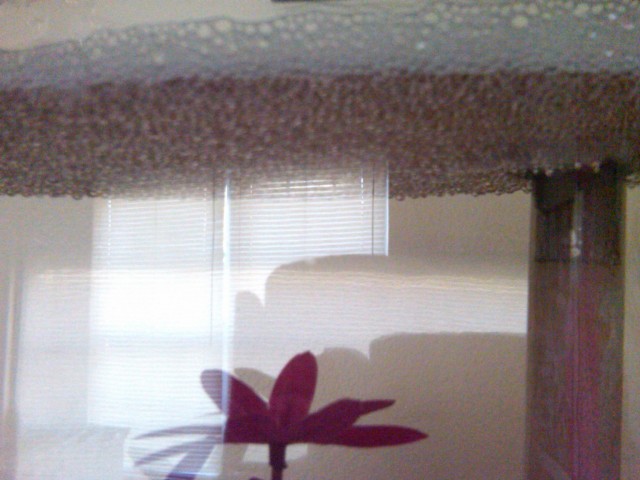 Bubbles in Tank
QuestionQUESTION: Recently I purchased a Petco mini one
Bubbles in Tank
QuestionQUESTION: Recently I purchased a Petco mini one
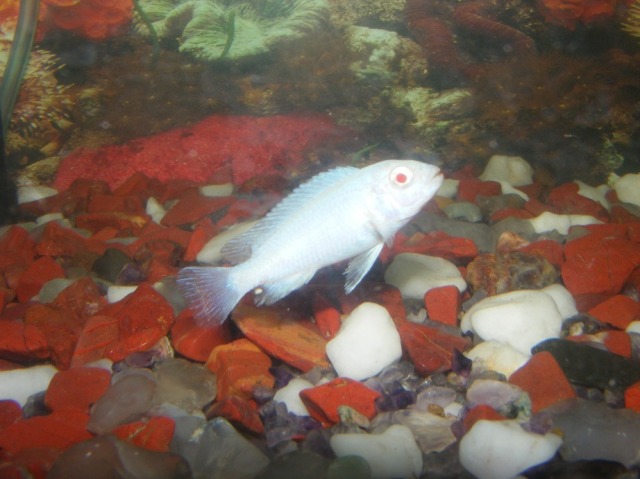 Cichlid identification
Question
Moonlight cichlid (?)
Sir,
Please have a look
Cichlid identification
Question
Moonlight cichlid (?)
Sir,
Please have a look
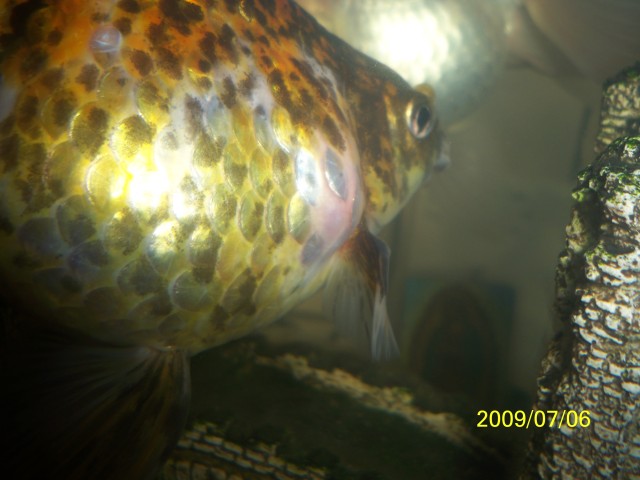 my goldfish has a red lump
Question
red bump on side of my
hi im joanna and I just
my goldfish has a red lump
Question
red bump on side of my
hi im joanna and I just
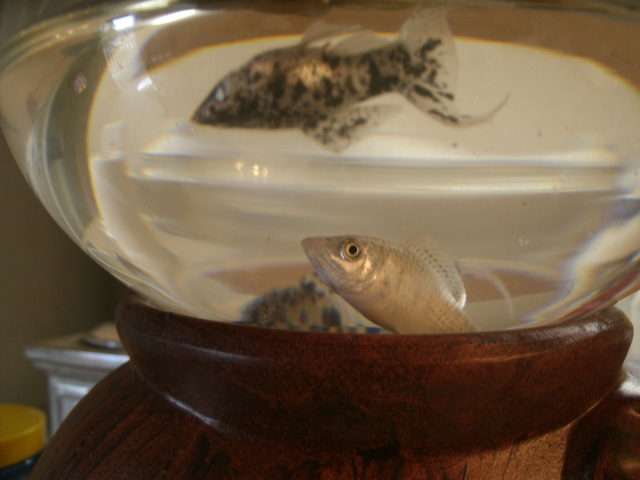 New fish; first time fish owner; Molly fish; tanks
Question
Fish Actual Tank
Hi. My roommate
New fish; first time fish owner; Molly fish; tanks
Question
Fish Actual Tank
Hi. My roommate
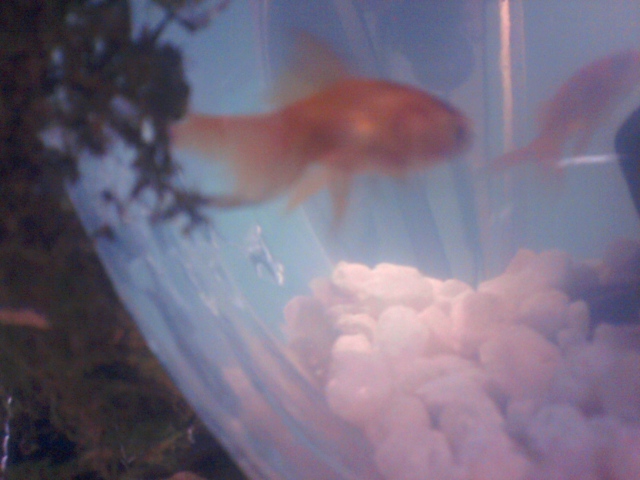 2 new small fantail goldfish
Question
say hello to my little
I got my fantails two n
2 new small fantail goldfish
Question
say hello to my little
I got my fantails two n